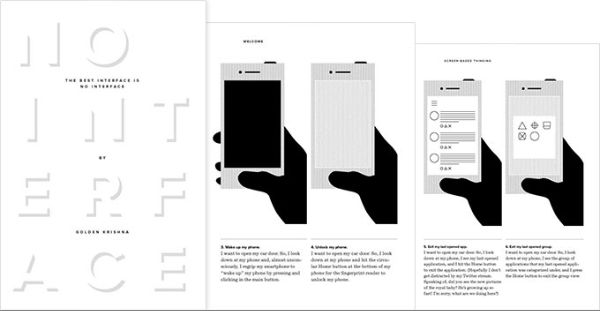🤖 + 🍺 Bots and Beer 1x00 - The Invisible Interface
The Bots + Beer newsletter ran for about 3 years between 2017-2020 during a time when I was highly involved in chatbot and artificial intelligence development. It was eventually folded into Codepunk as part of the Codepunk newsletter.
Some portions of this newsletter were contributed by Bill Ahern.

I gave a talk on chatbots at a recent JavaScript conference in Richmond, Virginia. The crowd was lighter than some of the other talks, and I've actually noticed a downward trend in attendance on sessions about chatbots. During the speaking engagement, I had the crowd look around at the room, and then asked them whether or not chatbots were still a thing. We hear about businesses and start-ups launching new chatbots, but rarely do I see someone pull out their phone, and actually use one.
There are three main factors that contribute to this: psychology, usability, and novelty. I use the term novelty to express the "newness" of conversational software, which although filled with hype, can also be an obstacle to adoption because of resistance to change. In the conference, I brought up my own 4 year old child's interactions with voice software:
"You're used to menus, buttons, and sliders, while my four year old son tries to change the radio station at a restaurant by calling out to Alexa"
Both my children treat Alexa like a human being, and have grown accustomed to interacting with "her." They're also both fluent with tablet usage and streaming media. Conversational software isn't a novelty to them; It's a way of life.
Our resistance is partly because of our upbringing. I'm 40. Bill's also in his 40's. The generation before us didn't trust computers. Our generation had to deal with bugs in both software and hardware. We mistrust the process more, and the software designed to encourage our interaction held our hand through each step. Now we're eliminating the steps in favor of an invisible, more conversational approach, and this has ignited a resistance because of uncertainty and unfamiliarity. Although Alexa is growing more and more popular, generally, users continue to shy away from voice-enabled purchases. We need to see. We need to click. Our children don't.
But is that enough?
Golden Krishna, in his book The Best Interface is No Interface, denounces our obsession not just with screens, but with the need to have screens everywhere--even where they aren't needed. All you have to do is think how often you're on your phone while you're in the bathroom to see how our tech obsession might be getting out of hand (…and be sure to wash that hand while you're at it). Truly great technology has become ubiquitous with daily life; It's invisible. You no longer think of it as technology.
As we approach the age of the Internet of Things, we rapidly begin to see the need for better, more invisible interfaces. SmartThings and Alexa are great, but my wife is not likely to set up any routines or scenes anytime soon. The interface is good, but it hasn't faded into the automatic behaviors of turning on light switches or checking a thermostat as you walk by. Those who are early adopters can use it, but until that usage is seamless with everyday life and modern culture, it's a digital lifestyle instead of just a lifestyle.
This is why the next frontier of user experience design and engineering has nothing to do with the web or the smartphone, but instead about building fluid conversational software and "invisible" interfaces that enable daily routines rather than augment them. Appropriately parsing language for accurate commands--whether through text or voice--is the beginning of a shift that will not only alter personal digital assistants and make chatbots useful, but it will create acceptance and trust between user and user interface that as of today is very much missing.
Better Software Through Design
As a programmer, building great software is often couched in a programmer mindset. Project-based work is filled with incomplete administration screens that brokenly allow you to trudge through what is otherwise poetic engineering. It's often why usability has been such a focus in the last decade. It isn't enough to build great software; You must build usable software. This is often easier said than done.
Not that long ago I came across a company named Zeit--a cloud deployment company trying to make the process of launching an application as easy and seamless as possible. I was immediately captivated by the focus on clean, minimalist design--not just with their web site, but with their products, especially the Now CLI. This Node.JS command line client allows you to deploy an application to their cloud service simply by typing now in the root directory of your web application. If you have a package.json file, it'll read it for deployment instructions. Once deployed (in seconds), it gives a unique URL right in the command line that you can launch to see your application. Each subsequent deployment gives a different URL, so you can compare deployments.
I've been obsessed with the way their tool has been evolving because each step shows the value of attention to design. You can deploy your application, purchase a domain, and immediately alias it with a small command (now alias my-app-xsd21s.now.sh myapp.com), requiring only a confirmation.
When we talk about chatbots, voice commands, and the future of an invisible interface, it begins with quality design of natural language commands, and I think the industry could learn a lot from what Zeit is doing.
Surveillance in Utopia and Dystopia
Bill and I had the opportunity to chat about what a world of data may or may not look like in the future. Readers of this newsletter should be familiar with the topic from some of our previous newsletters. It's going to be a topic that I'm sure most people will be revisiting time and time again.
The Data Required
Are we rehashing things too much if we talk about data collection again? Unfortunately, in no world is an invisible interface possible without software and machines that can intuit our needs. This requires lots and lots of data. We've debated plenty of times in the past the different avenues where this can be acceptable. It's a hard question, and I'm not sure anyone has a great answer yet.
Lennart Ziburski has an in-depth essay exploring how data distribution across companies and applications is actually preventing us from establishing a high-quality personal digital assistant, capable of a refined invisible enhancement to our personal lives.
"If data is the new oil, where are our cars?" --Lennart Ziburski
Data doesn't exist in its most capable form on our devices. Instead, our data is fractured among different services that harvest our data for their own gain, and to do so, they subscribe to tactics meant simply to increase engagement rather than improve our lives.
Ziburski posits that a "circle of knowledge" interface, in which we personally control our data, but establish our own auditing--either segregating applications and data, or allowing applications and data to share with each other--will create an overall experience where we can control corporate usage of our data, while training our on-device artificial intelligence with the right data for making the best decisions and suggestions for it. We enhance the invisible interface by controlling how data is shared.

Jameson Craft Beer Barrel Stout Edition
The Jameson Craft Beer Barrel Stout Edition my new favorite whiskey. Even if you aren't a fan of Jameson or Irish Whiskey in general, this has such a smooth smokey taste with a discernible vanilla finish that the only way to drink it is straight or on the rocks, as this is definitely not, IMO, a cocktail whiskey. Mixing it would do your palate no favors.